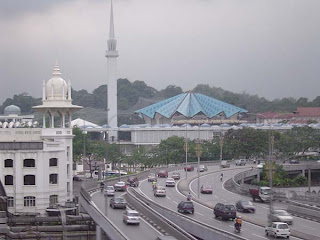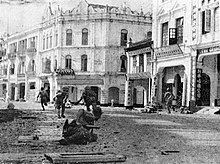
Here some info that i know to be share with all of you:
Kuala Lumpur is capital city of Malaysia. The city full of history and full with interesting places to visit. located in the center of peninsula Malaysia,
Kuala Lumpur (
Jawi: كوالا لومڤور; translated as: "muddy confluence," "muddy estuary," and "muddy city"; pronounced
/ˈkwɑːləlʊmˈpʊər/ in English;
Malay [kwɑlɑlʊmpʊ], locally
[kwɑləlʊmpɔ] or even
[kɔlɔmpɔ],
and often abbreviated as
K.L.) is the capital and largest city of
Malaysia. The city proper, making up an area of 244 km
2 (94 sq mi), has an estimated population of 1.6 million in 2006. Greater Kuala Lumpur, also known as the
Klang Valley, is an urban agglomeration of 7.2 million. It is the fastest growing metropolitan region in the country, in terms of population as well as economy.
The geography of Kuala Lumpur is characterized by a huge valley known as Klang Valley. The valley is bordered by the Titiwangsa Mountains in the east, several minor ranges in the north and the south and the Strait of Malacca in the west. Kuala Lumpur is a Malay term which translates to "muddy confluence" as it is located at the confluence of the Klang and Gombak rivers.Located in the center of Selangor state, Kuala Lumpur was previously under the rule of Selangor State Government. In 1974, Kuala Lumpur was separated from Selangor to form the first Federal Territory governed directly by the Malaysian Federal Government. Its location on the west coast of Peninsular Malaysia, which has wider flat land than the east coast, has contributed to its faster development relative to other cities in Malaysia.The municipality of the city covers an area of 243.65 km2 (94.07 sq mi), with an average elevation of 21.95 m (72.0 ft).
Kuala Lumpur also has a mix of different cultures which include Malays, Chinese, Indians, Eurasians, as well as Kadazans, Ibans and other indigenous races from East Malaysia and Peninsula Malaysia.
Kuala Lumpur's rapid development triggered a huge influx of low skill foreign workers from Indonesia, Nepal, Burma, Thailand, Bangladesh, Pakistan, India, Sri Lanka, Philippines, and Vietnam into Malaysia, many of these low skill workers enter the country illegally or without proper permits .[36][37]. However, at the same time there are more than 500,000 Malaysians, of which are mostly professionals and highly skill peoples working or residing abroad.
In the late-18th century, when Europe underwent Industrial Revolution, large groups of Chinese from Fujian and Guangdong in China were brought in to Malaya to work in the booming tin mining industry. The Chinese in Kuala Lumpur speak different dialects but the majority in Kuala Lumpur are of Cantonese descent, and the Hakkas.
Indians form 10% of the population in Kuala Lumpur (as in 2000), mostly practise Hinduism and speak Tamil and other Indian and Pakistani languages such as Urdu, Malayalam, Punjabi, Telugu and Pashtu. Historically, most of the Indians were brought in during the British colonisation of the Malaysia. Their popular festivals are Thaipusam, Deepavali and Pongal.
Islam is practised primarily by the Malays and the Indian Muslim communities. Other major religions are Hinduism (mainly among Indians), Buddhism, Confucianism and Taoism (mainly among Chinese) and Christianity. The city has many places of worship catering to the multi-religious population.
Unlike most other Asian cities, driving is the main mode of commuting in Kuala Lumpur. Hence, every part of the city is well connected by highways. As capital of Malaysia, Kuala Lumpur has a comprehensive road network that leads to the rest of Peninsular Malaysia.
In terms of air connectivity, Kuala Lumpur is served by two airports. The main airport, Kuala Lumpur International Airport (KLIA)at Sepang, Selangor, which is also the aviation hub of Malaysia, is located about 50 kilometres (31 mi) south of city. The other airport is Sultan Abdul Aziz Shah Airport, formerly known as Subang International Airport and served as the main international gateway to Kuala Lumpur from 1965 until KLIA opened in 1998. KLIA connects the city with direct flights to destinations in six continents around the world, and is the main hub for the national carrier, Malaysia Airlines and low cost carrier, AirAsia. KLIA can be reached using the KLIA Ekspres high-speed train service from KL Sentral which takes only twenty-eight minutes, while travelling by car via highway will take about an hour. Air Asia flights do not fly out of KLIA main terminal but from the LCC terminal, which is served by buses from KL Sentral, and is a 20-30 minute taxi ride from the main terminal. As of 2007, Sultan Abdul Aziz Shah Airport is only used for chartered and turboprops flights by airlines such as Firefly and Berjaya Air.
Public transport on Kuala Lumpur and the rest of the Klang Valley covers a variety of transport modes such as bus, rail and taxi. Despite efforts to promote usage of public transportation, utilisation rates are low as only 16 percent of the population used public transportation in 2006. The rapid transit system in Kuala Lumpur consists of three separate rail systems which meet in the city and extends towards other parts of Klang Valley. The rail systems are RapidKL RAIL, KL Monorail, and KTM Komuter. These lines have either underground or elevated stations around the city. The main rapid transit hub is KL Sentral which facilitates as an interchange station for the rail systems. KL Sentral is also a hub for intercity railway operated by KTM Intercity. It provides rail services to as far as Singapore in the south, and Hat Yai, Thailand, in the north.
The largest public transportation operator in Kuala Lumpur and the Klang Valley is RapidKL. Since the take over from Intrakota Komposit Sdn Bhd, RapidKL has redrawn the entire bus network of Kuala Lumpur and Klang Valley metropolitan area to increase ridership and improve Kuala Lumpur's public transportation system. The management of RapidKL has adopted the hub and spoke system to provide greater connectivity, and cut down the need of more buses. RapidKL is also the operator of three rapid transit rail lines in Kuala Lumpur, namely Ampang Line, Sri Petaling Line and Kelana Jaya Line.
In Kuala Lumpur, most taxis have distinctive white and red liveries. Kuala Lumpur is one of the major ASEAN city with taxis extensively running on natural gas natural gas vehicle. To hail a taxi, you normally just wait on the street or go to locations called taxi stands. Nevertheless, taxis are known to charge high rates for foreigners. Make sure the driver will use the meter.
Kuala Lumpur is served by
Port Klang, located about 64 km (40 mi) southwest of the city. The port is the largest and busiest in the country handling about 6.3 million
Twenty-foot equivalent units (TEU) of cargo in 2006.















